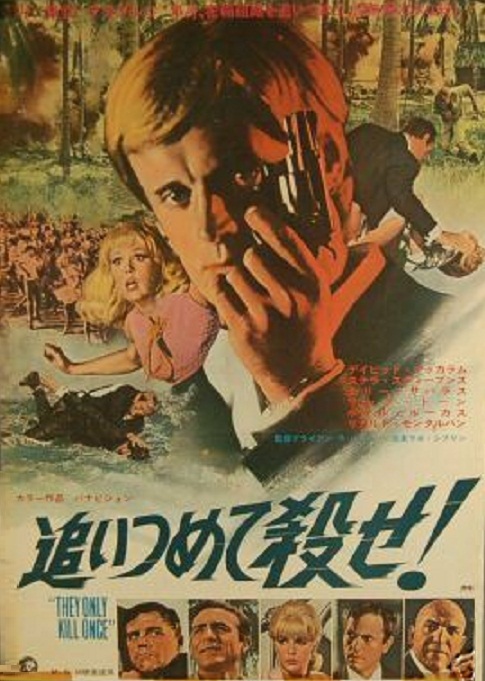Wild Seed
A wartime
romance, a cross-country trip (the unacknowledgeable daughter and a young
hobo), the father a Los Angeles piano merchant, the foster parents in New York
(foster dad even “remembers” dandling her in didies).
The kids in L.A.,
with their whole future before them.
Sol
Madrid

The drug trade,
by a veteran of The Untouchables
(like Rip Torn, Pat Hingle, Telly
Savalas and Michael Ansara) out of the author of Written on the Wind (dir. Douglas Sirk).
The form and
structure are suggested by Terence Young’s The
Poppy Is Also a Flower, Interpol for the United Nations in the strangely
repeated European war (strangely imitated in his Inchon).
Thus the undercover
man as junkie in a raid that is remembered by Friedkin in The French Connection (Coppola has the liquidation of Scarpi in The
Godfather), and then as middleman hauling the stuff from Mexico to the U.S.
in order to retire early with millions (the salutary demonstration of his oil
pipeline system for smuggling a load of heroin out of Tijuana to a San Diego
buyer goes into George Roy Hill’s The
Sting), a prismatic view typical of Hutton.
Renata Adler of the New
York Times, “it is a strong cast.” Despite “certain
confusing story elements,” Variety
found “direction by Brian G. Hutton is a potent assist to film’s unfoldment.” TV Guide, “neatly crafted thriller... admirably campy”. Hal Erickson (All
Movie Guide), “drug-ring melodrama.” Catholic News
Service Media Review Office, “routine crime melodrama”. Halliwell’s Film Guide, “humdrum,
predictable, brutishly violent”.
Where Eagles Dare
A commando raid
to rescue an American general exposes Nazi infiltration of M.I. 6.
The sheer
exhaustiveness of the film is partly its theme, nothing if not thorough.
Robert Beatty is
there from Crichton’s Against the Wind, significantly, and to show the
difference between the two films, which is the rest of the theme.
Kelly’s Heroes
Hutton’s immensely
complicated masterpiece is built upon Lewis Milestone’s A Walk in the Sun.
It takes a key premise from John Sturges’ The Magnificent Seven (the
supposed gold in them thar hills) and expands it by way of Fritz Lang’s Siegfried
to understandable proportions. To the common soldier belongs the dragon-gold of
war, bloody death. That is the sense in which Sergio Leone is encountered at
the climax, and also there is the quite beautifully ironic analysis of Stanley
Kubrick’s Paths of Glory in the light of Robert Frost’s poem, “Design”.
Last but not least, the German sergeant in command of the Tiger tank guarding
the gold is made to resemble Col. Hessler in Ken Annakin’s Battle of the
Bulge.
X Y & Zee
The domestic
tribulations of a mistress and wife brought down to cases. The architect
notices slipshod work in the new flat he’s taken with the former. The latter
notices it, too.
Zee is the last
word in wifely wit, the raison d’être, her rival a will o’ the wisp.
Hutton’s
dissolves advance toward The First Deadly Sin in more than one instance.
Night Watch
A wealthy woman
(Elizabeth Taylor) married to a stockbroker (Laurence Harvey), and still
recovering from the shock of her former husband’s death in the arms of another
woman, gets the better of the blighter this time as he’s planning to steal her
fortune and fly off to Bermuda with her best friend (Billie Whitelaw).
A set like
Freud’s office with lantern figures overlooking the garden by lightning, an old
house beyond it, and a neighbor with a spade yet not so watchful, at first.
The First Deadly Sin
The First
Deadly Sin is one of the earliest
representations of the Yuppie persona, that is, Young Upwardly-mobile
Professional (cp. Mon oncle
d’Amérique, dir. Alain Resnais).
This specimen likes to kill people with a mountain-climber’s hammer, a
square-headed stainless-steel implement with a long curving claw.
Much of the film
is devoted to Sgt. Delaney’s efforts at determining the murder weapon from the
injuries it causes, though we are shown the thing in action right from the
start. Sgt. Delaney goes to the Metropolitan Museum of Art, whose curator of
antique arms shops around in a hardware store and a sporting goods store.
Finally Sgt. Delaney is able to trace the buyer of one of these rare tools to
an unusually decorated apartment (the doorman takes a bribe). Sparse, white
décor, crystal sculptures, lighting system, and the hammer wrapped in plastic
in a closet.
The murderer has
close-shorn hair under his wig, and has a penchant for crying in a fetal
position under the shower, when he isn’t busy at his exercise machine or
climbing knotted ropes (he even wears a black undershirt beneath his white
shirt and tie). A dark trenchcoat completes his attire as he passes his prey on
the sidewalk, then turns around and pierces their brains from behind.
Hutton accompanies
this revelation with masterful violations of standard editing practice, so that
the murderer bursts into his room where Mrs. Delaney is dying in a hospital, or
his frosted glass shower door suffers the passage of Sgt. Delaney into an
office. The interlocking parts of the story interchange in this way during the
first half, and a lighted crucifix outside a church, a snapshot of a victim’s
family, etc.
High Road to China
Constantinople to
Waziristan and Katmandu, then over the Himalayas, to find the Yankee end of an
Anglo-American partnership.
It defends a
hilltop village from a marauding warlord.
The British end
wants all, stints no effort, there’s the lie of the land.
Society flapper
hires disheveled ace to fetch well-heeled father about to be declared legally
dead, in brief, a reworking of Wild Seed.